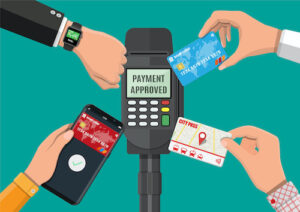Digital payments have seen an uptick on campuses and beyond as a preferred form of payment. According to the Pew Research Center, 41 percent of Americans say none of their purchases in a typical week are paid for using cash. This statistic is up from 29 percent in 2018 and 24 percent in 2015, reflecting an accelerating preference for contactless transactions.
Digital payments improve experiences for students and businesses on campuses nationwide. Staff and students gain convenience and security from paying with biometric-enabled devices. Businesses gain increased visibility into purchases, reduced administrative responsibilities and potentially increased revenue with flexibility in accepting payments.
However, not every college or university has fully moved to cashless payment systems. Here are four critical steps to help ease the transition:
1. Define and articulate benefits. The first step in implementing a cashless system involves determining how going cashless can solve specific issues on campus. For example, at the University of North Carolina, Charlotte, the university implemented digital payments in dining operations. Rather than going through a cashier line, students paid digitally. They could also order in advance. The change eliminated lines at dining operations, saved students time, and helped dining operations keep up with the volume of dining traffic.
2. Test assumptions under real-world conditions. Before fully implementing a cashless system, walk through the many transactions that staff, students, and visitors make on campus and see how they can benefit from being cashless. This can help in prioritizing projects. Miami University started a cashless transition in 2011 by shifting to electronic tuition payment instead of having students walk up and pay at the bursar’s office. Following, they converted vending machines to accept card payments only, including credit and prepaid, and they transitioned parking payment systems from cash to kiosks that accepted card payments. Now, students can pay by card at Miami and many other universities to do laundry, at on-campus stores, at copy machines and more.
a3. Prepare for events that could derail your plan. After transitioning to a cashless campus, administrators at Pace University in New York City highlighted the critical need to create and execute a communications plan for informing students and faculty of upcoming changes. This includes explaining the reasoning behind the change and highlighting the benefits. It’s also essential to communicate the move to cashless systems to campus visitors, especially those who rarely visit the campus except for special events. Universities can post notices at event locations and communicate through social media and e-newsletters.
According to the study by Pew Research Center, not everyone has embraced cashless payment systems. It’s vital for campus administrators to factor in the demographics of their campus population to see if and where the move toward digital payment might create challenges and if there are solutions that could support the entire community while maintaining the commitment to going cashless.
4. Seek out the best ideas. At Virginia Commonwealth University (VCU), many of the best ideas for transitioning to a cashless campus came from the campus community. VCU has student committees, student government, and a student technology committee specifically engaged to deal with issues like digital payments. Tapping into student committees to opine on digital payment transition can uncover unique ideas and feedback.
A college campus is like a micro-society, and, like the larger society, campuses are moving toward digital systems as the preferred payment method. Thanks to advances such as smartphones and smartwatches and the physical security credentials required by these devices, students and faculty are benefiting from myriad security and convenience benefits. Higher education institutions also benefit through greater efficiency, reduced costs for services such as armored vehicles and the ability to create a more student-friendly campus.
Related:
3 ways software drives higher-ed payments innovation
- Network security in higher ed: The importance of zero trust - July 16, 2025
- Using AI to reimagine teacher preparation for scale, equity, and reflective practice - July 15, 2025
- It’s time for higher education marketing to wake up - July 11, 2025
